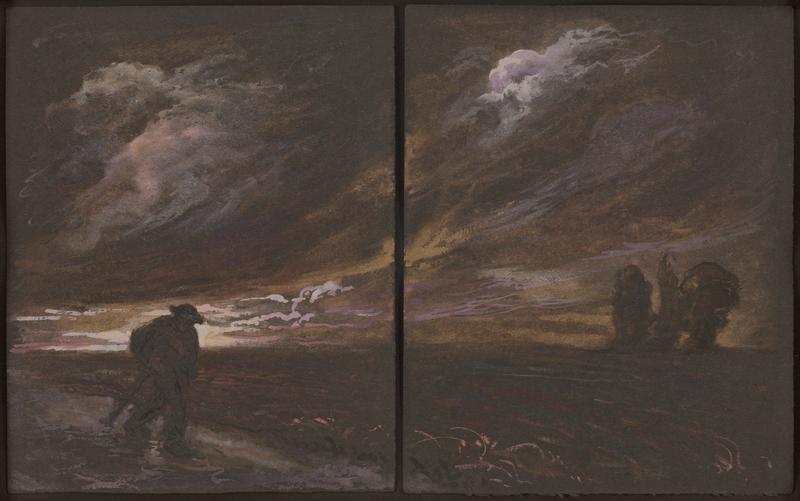
57. Paul-Émile Colin, Returning from the Fields
| Artist | Paul-Émile Colin, French, Lunéville 1867–Bourg-la-Reine 1949 |
| Title, Date | Returning from the Fields (Le retour des champs), c. 1915 |
| Medium | Pastel, gouache, and metallic ink on thick black wove paper |
| Dimensions | 10 × 12 1/2 in. (25.4 × 31.8 cm) (each sheet) 20 1/4 × 12 1/2 in. (51.4 × 31.8 cm) (overall) |
| Provenance | Atelier Paul-Emile Colin sale, Frédéric de Metz-Noblat and Laurent Thomas, Metz, France, January 25, 2004; [Armstrong Fine Art, Chicago; to Weisberg]; Yvonne and Gabriel Weisberg, Minneapolis |
| Exhibition History | "Reflections on Reality: Drawings and Paintings from the Weisberg Collection," Mia, 2022–23 |
| Credit Line | Promised gift of Gabriel P. and Yvonne M.L. Weisberg, Minneapolis |
Before Paul-Émile Colin became an artist, he intended to practice medicine. He was still in medical school in 1887 when he enrolled in the Académie Colarossi, a progressive art school in Paris. Through his connection to fellow student Charles Filiger, he met Paul Gauguin on a visit to the village of Le Pouldu, in Brittany. This wasn’t far from Pont-Aven, a haven for symbolist artists. The experience left Colin with an interest in flat planes of color and mystical Symbolism. As time went by, he absorbed other influences, and his work often betrays undertones of such artists as Jean-François Millet and Camille Pissarro.
By 1901 Colin had given up medicine to concentrate on art. He focused on woodcuts but also made other kinds of prints, as well as paintings and pastels. Sometimes, as here, his pastels display a nervous energy not seen in his highly methodical woodcuts. In this view of a road at sunset, the artist lit up the sky with pinks, whites, and glistening gold. His remarkably varied technique yielded sinuous lines, minute atomized dots, and smudged areas of color. Trees on the horizon lend scale to the wide, flat field. Silhouetted against the sky is a man walking with the aid of a staff. We sense his fatigue as well as the distance he must travel before he can rest.
Made on two sheets of paper, each about 10 by 12 inches, the pastel may have been a design for the cover or endpapers of a deluxe book. We have yet to link Returning from the Fields to a specific project, but we know that Colin’s activity as a book illustrator was prodigious, especially during the 1910s and 1920s.
Despite his membership in various professional societies and being made a knight of the Legion of Honor, Colin had fallen into obscurity until 1980, when a museum in his hometown, Lunéville, organized a show of his prints. He has since received more attention in exhibitions and scholarly studies.1
TER
Notes
See Françoise Copeland et al., L’été des néo-impressionnistes expose Paul-Emile Colin, graveur (exh. cat.), Musée Gatien-Bonnet (Lagny-sur-Marne, France, 2007); Eva Gilbert-Levrier, Un artisan du renouveau de la gravure sur bois à la fin du XIXe siècle: le graveur lorrain Paul-Emile Colin, master’s thesis, Université Paris-Sorbonne, Paris IV, 1980; Nathalie Tailleur, “Paul-Emile Colin, redécouverte d’un graveur,” Péristyles, no. 14 (November 1999), pp. 28–36; and Martin Hopkinson, “Notes,” Print Quarterly, vol. 25, no. 2 (June 2008), pp. 197–98. ↩︎